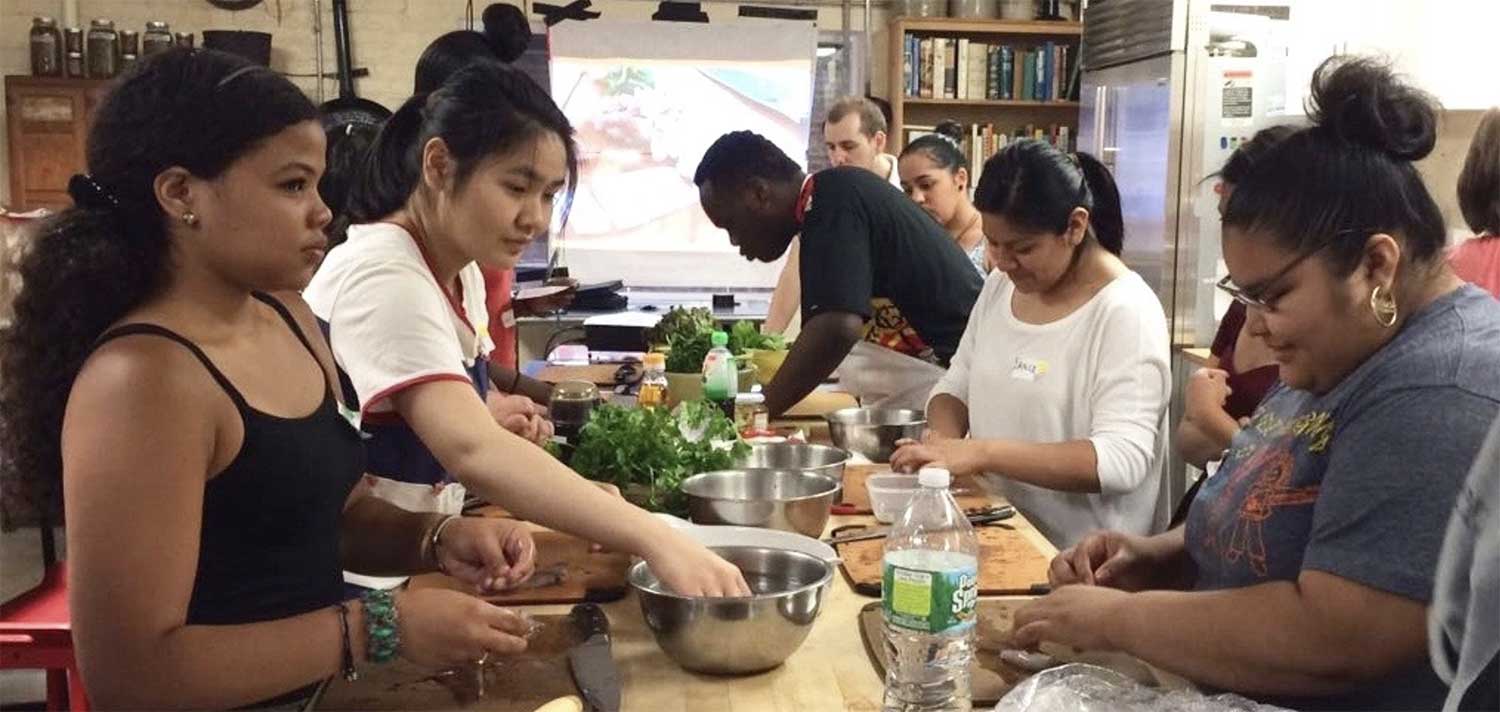What Is a Teaching Kitchen?

Creating Helpful Definitions for Teaching Kitchen Initiatives
We’ve been busily developing projects for a wide range of new and potential clients across the US. As we do so, it’s become clear that many Teaching Kitchen-related terms lack consistent definitions. Just this week, I was asked to explain the difference between cooking classes and a Teaching Kitchen! And we’re still fielding the simple question “What is a teaching kitchen, anyway?”
Terms like ‘culinary medicine,’ ‘teaching kitchen,’ and ‘culinary nutrition education’ are being used interchangeably. We think it’s high time to suggest a specific definition for a Teaching Kitchen.
What Is a Teaching Kitchen?
Culinary schools consider any of their kitchens where students learn to cook to be ‘teaching kitchens.’ However, this definition is literal for teaching future chefs for food service and does not include any connection to health.
The Teaching Kitchen Collaborative is led by Harvard’s T.H. Chan School of Public Health and the Culinary Institute of America. They describe Teaching Kitchens as “Bridging Nutrition Science, Healthcare, and the Culinary Arts.” That is a useful concept to be sure— the bridging of disciplines.
But we think it could go a step further to provide the specific goal of the education.
How to Define a Teaching Kitchen in a Clinical Setting?
Our preferred definition for clinicians would be something like this:
A Teaching Kitchen is designed to induce a lifestyle change in eating behaviors among participants, through the activity of collaborative culinary skill-building and recipe strategies for measurable health outcomes.
The goal of clinical Teaching Kitchen education is to improve patients’ existing disease state or prevent disease onset.
Moreover, a Teaching Kitchen should aspire to achieve a ‘spillover effect’ among participants’ entire household. The whole family should experience a transformational relationship with food.
What happens in a Teaching Kitchen?
Teaching kitchens can incorporate many components, the most fundamental being:
- Nutrition education that informs about nutrients in food, their function in supporting health, and how to compose a balanced meal
- Hands-on culinary instruction and practice, with skill reinforcement for participants to achieve a level of competency
- Meal planning strategies that incorporate participants’ available resources and access to healthful food
- Goal setting and group support to address barriers and share successful strategies
Additional components that can enhance Teaching Kitchen effectiveness might include:
- Training in mindfulness, meditation and other techniques to address self-soothing with food and other psychological relationships with food and mood, etc.
- Best use of technology resources for food shopping, menu planning, etc.
- Inducements and motivation around physical activity that support comprehensive lifestyle shifts
What’s the difference between a Teaching Kitchen and nutrition education?
Teaching Kitchens are increasingly found in hospitals, clinics, and medical schools. But what about non-clinical settings? What is the difference between a Teaching Kitchen and any nutrition education —culinary or otherwise— in public schools, after schools, in foodservice or in workplaces?
It is our recommendation that the deciding factor in the definition of a Teaching Kitchen should be measurable behavior change.
A Teaching Kitchen should be synonymous with educational design that assures a certain level of behavior change and success in the same way that taking a prescription drug can reliably improve a disease. It’s less passive than a pharmaceutical and more patient-intensive, for sure. It relies on each patient’s own investment of time, energy and commitment. Happily, there are no ‘side effects’ or other risks. And there are ancillary benefits – building community among participants, among their families, culinary appreciation and skill-building, spilling throughout participants’ social networks. The list can go on and on.
While FamilyCook has a very strategic way in which we think about Teaching Kitchens, there are so many more distinctions left to make and terms to define. Let’s start a conversation! We want to hear from our Teaching Kitchen network in the comments below:
What do you think about our proposed distinction between a Teaching Kitchen and cooking classes in clinical settings? How do you answer the question, “What is a Teaching Kitchen?”
We’ll be covering more distinctions, points of view, and terms in the near future, so stay tuned to our Teaching Kitchen Blog and let us know if there’s anything you hope to see covered here!


2 Responses
I would like to be apart familycook production has an culinary educator.
Hi Kenesha! Thrilled to hear it! Please contact us at https://familycookproductions.org/contact-us to inquire about culinary instructor opportunities.